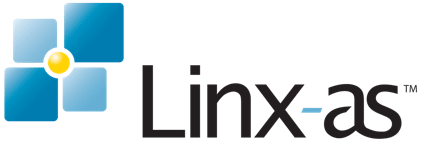Established in 2000, Linx-AS has core consulting practices in product lifecycle management (PLM), environment, health, and safety (EHS), and enterprise user experience (UEx). The business helps large companies implement more profitable product development processes, ensure operations are within regulated environment, health, and safety standards, and, overall, make SAP easier for people to access and use. Additionally, its Innovations Division focuses on designing SAP-certified solutions and accelerators that provide faster time to value for customers.
 Linx-AS helps businesses be more of what they aspire to be with SAP—strategic, innovative, sustainable, productive, and profitable. In doing so, it brings the highest level of expertise to its customers, delivering thoughtfully designed and meticulously implemented solutions.
Linx-AS helps businesses be more of what they aspire to be with SAP—strategic, innovative, sustainable, productive, and profitable. In doing so, it brings the highest level of expertise to its customers, delivering thoughtfully designed and meticulously implemented solutions.
With deep industry knowledge and a commitment to value realization, the SAP partner ecosystem is critical to the success of the chemical industry. SAP partners help customers of all sizes, in countries worldwide take advantage of SAP’s innovative solutions, simplify their business processes, and orchestrate the Intelligent Enterprise. To bring this perspective to the SAP community in the chemical industry, we are continuing with our third edition of the Chemical Industry Partner Stage series.
Here, we talk with Jeff Frye, president and CEO of Linx-AS.
Q: When you talk to chemical customers, what excites you about the chemical industry?
A: First off, the chemical industry is where Linx-AS got its start in 2000 with our environment, health, and safety consulting practice, so our chemical roots run deep. Since that time, the many changes and challenges chemical companies have faced—whether internal or external—have been met with innovation. It’s truly a dynamic industry, and that’s what makes working in chemicals exciting for us. We have earned insight on how chemical manufacturers operate and the business processes that drive success. It’s a natural fit for us to innovate with SAP technologies to deliver inspired customer solutions.
2020 was quite the year. What do you see as the top priorities for chemical customers in 2021?
Everyone was blindsided by the pandemic and the disruptions to life and business as we knew it. If there was a bright spot to 2020, it’s that the market and operational stresses were a catalyst for transformation trends that will continue as priorities through 2021.
Across industries, a predictable focus on worker health and safety emerged. I believe companies will continue to shore up foundational data and processes while exploring innovative ways, like mobile, the Internet of Things (IoT), and sensors, to extend the enterprise into the workplace.
Another priority will be research and development (R&D). Confronted with disrupted supply chains, the need for R&D agility became painfully apparent. Whether it’s reformulating products with substitute raw materials or developing for alternative markets, streamlining upstream definitely makes the list.
And then for chemicals especially, sustainability is key moving forward—not only taking care of what you produce now but driving sustainable product development for the future, which ties into R&D agility.
How has digital enabled these priorities from your perspective?
Digital is critical. I think there are a lot of definitions and expectations—or maybe aspirations—of digital floating around. For our customers, foundational work often needs to be done before realizing or even recognizing transformational opportunities. Reflecting on the priorities, simply centralizing data and digitalizing current processes in these areas is step one.
For instance, I mentioned health and safety initiatives. We’ve engaged in pilots and proofs of concept for mobile and IoT in this space to increase data collection and accuracy to ultimately drive decision-making and safety performance. The key takeaway is that you can collect all the data you want with sensors and apps. However, if your foundation isn’t solid, you can’t process the data in a meaningful way. To make digital effective, you must put data to work to deliver insights and drive workflow across the enterprise. My advice to customers is to definitely explore innovative solutions, but make sure you’re innovating on solid ground. That approach will lead to true transformation.
You just mentioned mobile. How do you see the mobile landscape in SAP, and do you have any advice for chemical customers embarking on mobile initiatives?
That’s a rich topic. There are so many factors to consider when looking at mobile, ranging from the technical to corporate policy to user personas to security. Are you running SAP S/4HANA or still on SAP ERP? Do you have a bring-your-own-device (BYOD) policy? Do your users require offline capabilities? It goes on and on. It’s an exercise we help clients with all the time. To sum up, the landscape is difficult. But the mobile landscape, particularly with cloud solutions from SAP, has a lot of potential for customers.
What I will say is that mobile is beyond exploratory; it’s expected now. It’s part of everyday life outside of work, so users demand it on the job with the same user experience (UX) performance. For some areas of SAP, you’ll require custom development to extend core capabilities. For instance, we’ve built a suite of risk management apps to augment SAP Environment, Health, and Safety Management by supporting additional use cases. For a customer in a development situation, I’d say pay attention to your users, use standard technologies, and choose an easily deployable architecture.
When we talk to chemical industry customers, big or small, change management is a key pillar of digital transformation. How do you see this topic in the industry?
It all comes down to communication. If you assess and understand the risks going into a transformation project, you’ll be prepared to navigate the challenges—and there are always challenges. If everyone impacted, from the top to shop, is engaged early, you’re on solid footing when you encounter bumps. It sounds simple, but it’s often difficult because of things that you can’t necessarily control. You need champions for your solution in impacted areas. Sometimes they’re not there or as vocal as needed. You need executive buy-in. Again, it’s another variable.
One thing we do at Linx-AS, a thing we can control, is constantly thinking of the end user in the solution—from design through implementation and support. Most failures can be attributed to breakdowns in user adoption. It’s critical to get user feedback and involve users in prototyping, so there are no surprises, or at least fewer, when you roll out and train your teams.
Why partner with Linx-AS?
What we hear most from our customers is usually one or all of three things: you understand our business, you really know SAP, and you give it to us straight. Because our focus in PLM and EHS is so specialized, we’ve invested heavily in our people, drawing from talent who have worked in industry and keeping them up to speed on the latest technology. It’s not commodity consulting that you can contract out. You need people who know the complexities of the chemical industry and have the business acumen to apply technology smartly. And, to the last of the three, that’s just how we do business. When you partner with Linx-AS, you get honest assessments of what will bring the most value to your business.
What makes Linx-AS different from other implementation partners in the chemical industry?
Echoing my last comments, our expertise in PLM and EHS, coupled with our understanding of the chemical industry, is unmatched. But, to expand on this, I’d say that our Innovations Division is truly a differentiator. We have a dedicated team that is churning out solutions that extend SAP. Whether it’s workflow solutions in recipe development or our WorkSafe Cloud offering for SAP Environment, Health, and Safety Management, we continually have an eye toward bringing added value to customers and designing solutions that engage end users.
How does Linx-AS create value for the chemical industry and how can people connect with you?
I’d go back to part of the Linx-AS vision statement that says, “We help businesses be more of what they aspire to be with SAP.” We understand chemical manufacturers have significant investment in SAP technology to realize benefits across the enterprise, but sometimes the path to value, particularly in the specialized areas of PLM and EHS, isn’t always clear cut. We simplify that path, provide focus for customers, and bring additional innovation to the platform that engages users and improves business performance.
As far as getting in touch, you can reach me at jfrye@linxas.com. For the latest on Linx-AS, you can go to our website or follow us at @LinxASLLC.
Looking to stay connected with the chemical Industry? Join the SAP Chemical Industry community on LinkedIn, follow us on Twitter @SAPChemicals, and check out our SAP Community page.
SAP is a leader in the chemical industry, and we are committed to continuous innovation. We encourage you to collaborate with us and discuss how the SAP solution portfolio can enable the intelligent enterprise in the chemical industry.
Mark Carlson is an chemicals solution expert at SAP.



